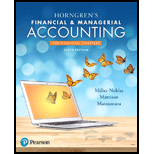
1.
No-par
Common stock: These are the ordinary shares that a corporation issues to the investors in order to raise funds. In return, the investors receives a share of profit from the profits earned by the corporation.
Par value: It refers to the value of a stock that is stated by the corporation’s charter. It is also known as face value of a stock.
To Journalize: the issuance of common stock for S Company.
2.
the amount of paid-in capital generated by the transactions recorded above for S Company.
Want to see the full answer?
Check out a sample textbook solution
Chapter 13 Solutions
Horngren's Financial & Managerial Accounting, The Financial Chapters (6th Edition)
- 18. How do you calculate the debt-to-equity ratio? A) Total liabilities / Total assetsB) Total liabilities / Total equityC) Total assets / Total equityD) Total equity / Total liabilitieshelparrow_forwardI need help with accounting questionarrow_forwardPlease Provide Solution of this General Accounting Question with Correct Methodarrow_forward
- Which of the following accounts is closed at the end of the accounting period? A) RevenueB) DividendsC) ExpensesD) All of the aboveneedarrow_forwardWhich of the following accounts is closed at the end of the accounting period? A) RevenueB) DividendsC) ExpensesD) All of the abovearrow_forwardI need help Which of the following is considered a non-operating activity? A) Sales revenueB) Interest expenseC) Salaries expenseD) Cost of goods soldarrow_forward
- 13. What is the main purpose of preparing a cash flow statement? A) To show a company's profitabilityB) To show the movement of cash in and out of a companyC) To show the company's net incomeD) To show the total liabilities of the companyarrow_forwardWhich of the following is considered a non-operating activity? A) Sales revenueB) Interest expenseC) Salaries expenseD) Cost of goods soldhelparrow_forwardWhich of the following is considered a non-operating activity? A) Sales revenueB) Interest expenseC) Salaries expenseD) Cost of goods soldarrow_forward
- 16. What is the primary difference between a trial balance and a balance sheet? A) Trial balance includes only liabilitiesB) Trial balance is prepared before financial statementsC) Trial balance includes only assetsD) Balance sheet is prepared daily, while trial balance is prepared monthly no aiarrow_forwardA company’s net income is $50,000, and its total assets are $200,000. What is the company’s return on assets (ROA)? A) 25%B) 20%C) 15%D) 10%arrow_forward16. What is the primary difference between a trial balance and a balance sheet? A) Trial balance includes only liabilitiesB) Trial balance is prepared before financial statementsC) Trial balance includes only assetsD) Balance sheet is prepared daily, while trial balance is prepared monthlyarrow_forward

 AccountingAccountingISBN:9781337272094Author:WARREN, Carl S., Reeve, James M., Duchac, Jonathan E.Publisher:Cengage Learning,
AccountingAccountingISBN:9781337272094Author:WARREN, Carl S., Reeve, James M., Duchac, Jonathan E.Publisher:Cengage Learning, Accounting Information SystemsAccountingISBN:9781337619202Author:Hall, James A.Publisher:Cengage Learning,
Accounting Information SystemsAccountingISBN:9781337619202Author:Hall, James A.Publisher:Cengage Learning, Horngren's Cost Accounting: A Managerial Emphasis...AccountingISBN:9780134475585Author:Srikant M. Datar, Madhav V. RajanPublisher:PEARSON
Horngren's Cost Accounting: A Managerial Emphasis...AccountingISBN:9780134475585Author:Srikant M. Datar, Madhav V. RajanPublisher:PEARSON Intermediate AccountingAccountingISBN:9781259722660Author:J. David Spiceland, Mark W. Nelson, Wayne M ThomasPublisher:McGraw-Hill Education
Intermediate AccountingAccountingISBN:9781259722660Author:J. David Spiceland, Mark W. Nelson, Wayne M ThomasPublisher:McGraw-Hill Education Financial and Managerial AccountingAccountingISBN:9781259726705Author:John J Wild, Ken W. Shaw, Barbara Chiappetta Fundamental Accounting PrinciplesPublisher:McGraw-Hill Education
Financial and Managerial AccountingAccountingISBN:9781259726705Author:John J Wild, Ken W. Shaw, Barbara Chiappetta Fundamental Accounting PrinciplesPublisher:McGraw-Hill Education





